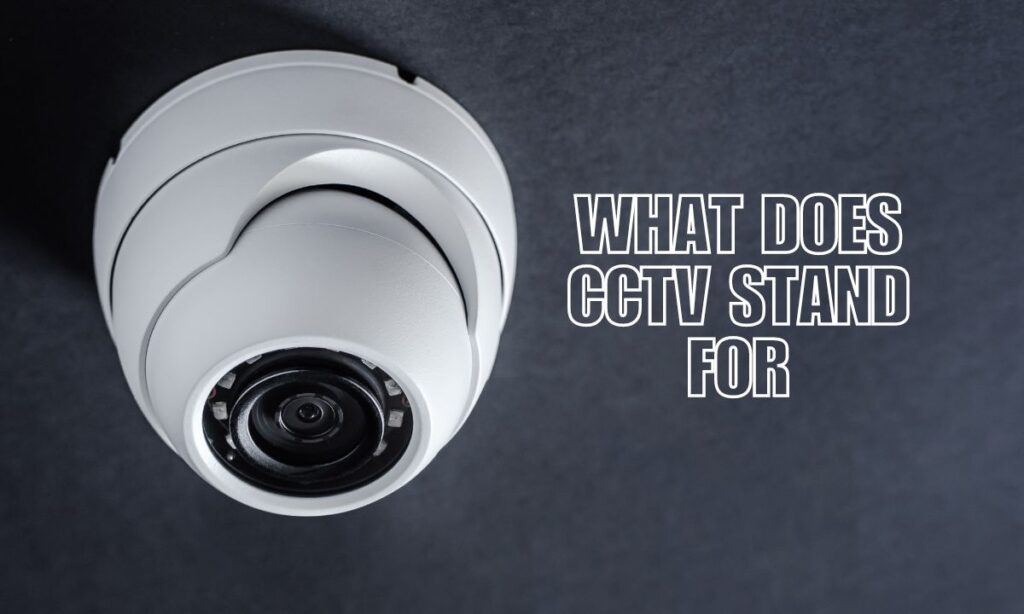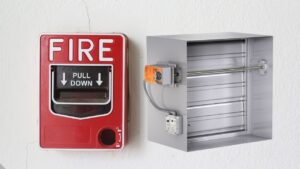CCTV stands for Closed-Circuit Television also known as a video surveillance system, used for surveillance and security purposes where video signals are transmitted privately to specific viewers. Unlike traditional television broadcasts, which are publicly accessible, CCTV is private and secure, designed to provide real-time monitoring or recorded footage for later review.
CCTV, or closed-circuit television, is a crucial component in modern security systems. Its primary function is to allow businesses, homeowners, and public authorities to monitor certain areas, such as entrances, public spaces, or private properties, ensuring safety and preventing crime. From preventing theft in a retail store to monitoring traffic in busy intersections, CCTV serves a wide range of practical applications.
Key Takeaways:
- CCTV is an acronym for Closed-Circuit Television
- It’s primarily used for surveillance and security purposes
- CCTV systems operate on a closed network, unlike broadcast television
- Modern CCTV incorporates advanced features like motion detection and facial recognition
- CCTV has applications beyond security, including traffic monitoring and industrial processes
What is CCTV and How Does it Work?
CCTV, or closed-circuit television, operates on a simple principle—transmitting video signals to a set of monitors via a private network. Unlike broadcast television, where signals are publicly accessible, CCTV restricts its transmission to authorized viewers, typically security personnel, building managers, or homeowners.
How CCTV Works
A basic CCTV system includes:
- Cameras: These capture live footage of specific areas.
- Monitors: Screens display the video feed from the cameras.
- Recording devices: Footage is stored for future viewing, using either digital video recorders (DVR) or network video recorders (NVR).
- Cables or Wireless Transmission: Connect the cameras to the monitors and recorders.
Advanced systems often incorporate motion sensors and remote viewing capabilities, allowing users to monitor activities via smartphones or computers, even when they are away from the property.

Understanding CCTV: Breaking Down the Acronym
The ‘Closed’ in Closed-Circuit Television
When we talk about CCTV being ‘closed’, we’re referring to the limited accessibility of the video feed. Unlike broadcast television, which is open for public viewing, CCTV operates on a closed network. This means that the video signals are transmitted to a specific, limited set of monitors or receivers. The closed nature of the system ensures that only authorized personnel can access the footage, maintaining privacy and security.
The ‘Circuit’ in Closed-Circuit Television
The term ‘circuit’ in CCTV refers to the complete path that the video signal travels. This circuit includes the camera, the transmission medium (which could be cables or wireless technology), and the receiving equipment (such as monitors or recording devices). The circuit is self-contained, creating a loop that keeps the video feed within a controlled environment.
The ‘Television’ in Closed-Circuit Television
While we might not immediately associate CCTV with the television sets in our homes, the ‘television’ part of the acronym highlights the visual nature of the technology. CCTV systems capture and transmit moving images, just like traditional television. However, instead of entertainment programming, CCTV focuses on real-time or recorded surveillance footage.
Types of CCTV Cameras
Different types of CCTV cameras are available, each suited to specific environments or purposes:
1. Dome Cameras
These cameras are typically mounted on ceilings and provide 360-degree coverage. They are commonly used indoors in retail spaces or offices.
2. Bullet Cameras
Long and cylindrical in shape, bullet cameras are ideal for outdoor surveillance. They offer long-range vision, making them perfect for parking lots or building perimeters.
3. PTZ Cameras
PTZ (Pan-Tilt-Zoom) cameras allow users to remotely control the camera’s movement and zoom in on specific areas. These are often used in larger environments like stadiums or public squares.
4. IP Cameras
IP (Internet Protocol) cameras transmit video over a network, allowing for remote access. They are popular for home and office security because of their ease of installation and flexibility.
The Evolution of CCTV Technology
From Analog to Digital: A Technological Leap
CCTV has come a long way since its inception. Early systems relied on analog technology, which had limitations in terms of image quality and storage capacity. Today, we’re seeing a shift towards digital CCTV systems. These modern systems offer higher resolution images, more efficient storage solutions, and the ability to integrate with other digital technologies.
The Rise of IP Cameras
One of the most significant advancements in CCTV technology is the introduction of IP (Internet Protocol) cameras. These cameras can send and receive data via computer networks, including the internet. This capability allows for remote viewing and management of CCTV systems, making them more flexible and scalable than their analog predecessors.
Advanced Features in Modern CCTV Systems
Modern CCTV systems are not just about capturing video. They now incorporate a range of advanced features that enhance their effectiveness:
- Motion Detection: Cameras can be programmed to start recording only when they detect movement, saving storage space and making it easier to identify important footage.
- High-Definition Video Quality: Today’s cameras provide clear, high-definition images, making it easier to identify faces, objects, and activities. This is particularly useful for forensic purposes.
- Remote Monitoring: With the advent of internet-based CCTV systems, users can view live footage from their cameras remotely via their smartphones or computers. This feature is especially useful for business owners and homeowners who need to monitor their property while they are away.
- Facial Recognition: Some high-end systems can identify and track specific individuals, which can be particularly useful in high-security environments.
- Night Vision: Infrared technology allows CCTV cameras to capture clear images even in low-light conditions.
- Pan-Tilt-Zoom (PTZ) Capabilities: These features allow cameras to be remotely controlled, providing a wider range of coverage.
Applications of CCTV Beyond Security
Traffic Monitoring and Management
While security is the primary application of CCTV, its uses extend far beyond. Many cities use CCTV systems for traffic monitoring. These cameras help traffic control centers manage congestion, respond to accidents quickly, and even assist in enforcing traffic laws.
Industrial Process Monitoring
In industrial settings, CCTV plays a crucial role in monitoring production processes. Cameras can be placed in areas that are difficult or dangerous for human operators to access, allowing for continuous monitoring of critical operations.
Retail Analytics
Retailers use CCTV not just for preventing theft, but also for analyzing customer behavior. By studying footage of how customers move through stores and interact with products, businesses can optimize their layouts and improve the shopping experience.
Healthcare Applications
In healthcare settings, CCTV is used to monitor patients, especially in intensive care units or for patients who require constant supervision. This allows medical staff to keep a close eye on patients’ conditions without being physically present in the room at all times.
The Impact of CCTV on Privacy and Society
Balancing Security and Privacy Concerns
The widespread use of CCTV has sparked debates about privacy and surveillance. While CCTV can enhance public safety and help solve crimes, there are concerns about the potential for misuse and the erosion of personal privacy. It’s crucial to strike a balance between security needs and individual rights.
Legal and Ethical Considerations
The use of CCTV is subject to various laws and regulations, which vary by country and jurisdiction. These laws often dictate where cameras can be placed, how long footage can be retained, and who can access the recordings. As CCTV technology continues to advance, legal frameworks are evolving to address new capabilities and potential privacy implications.
Public Perception of CCTV
Public opinion on CCTV is often divided. Some view it as a necessary tool for maintaining safety and order, while others see it as an intrusion into personal space. Understanding these differing perspectives is important for policymakers and security professionals when implementing CCTV systems.
The Role of CCTV in Home Security
CCTV plays a critical role in home security. Homeowners can monitor their property in real time and be alerted of any suspicious activity immediately. Whether it’s monitoring a front porch for package deliveries or securing the backyard, CCTV systems offer peace of mind.
Why Homeowners Choose CCTV Systems:
- Deterrence of Theft: The presence of visible cameras often discourages burglars.
- Real-Time Monitoring: Homeowners can view live footage from anywhere, enhancing their ability to react quickly.
- Evidence Collection: In case of a break-in or vandalism, recorded footage can provide crucial evidence to law enforcement.
- Integration with Alarm Systems: Many CCTV systems integrate seamlessly with alarms and smart home technologies, offering a comprehensive security solution.
The Future of CCTV Technology
Integration with Artificial Intelligence
The future of CCTV lies in its integration with artificial intelligence (AI). AI-powered systems can analyze vast amounts of footage in real-time, identifying patterns and anomalies that human operators might miss. This could revolutionize how we approach security and surveillance.
Smart City Applications
As cities become ‘smarter’, CCTV is playing an increasingly important role. Integrated with other urban technologies, CCTV can help manage everything from traffic flow to energy usage, contributing to more efficient and sustainable urban environments.
Challenges and Opportunities
While the future of CCTV looks promising, it also presents challenges. Issues of data privacy, cybersecurity, and the ethical use of advanced surveillance technologies will need to be addressed. However, if managed responsibly, CCTV technology has the potential to contribute significantly to public safety and urban management.
Frequently Asked Questions About CCTV
How does CCTV differ from regular television?
CCTV differs from regular television primarily in its purpose and accessibility. While regular television broadcasts content for entertainment or information to a wide audience, CCTV transmits video signals to a limited set of monitors for surveillance and security purposes.
Can CCTV footage be used as evidence in court?
Yes, CCTV footage can often be used as evidence in legal proceedings. However, the admissibility of the footage depends on various factors, including how it was obtained, its quality, and the specific laws of the jurisdiction.
How long is CCTV footage typically stored?
The retention period for CCTV footage varies widely depending on the purpose of the system, storage capacity, and legal requirements. It can range from a few days to several months. Many systems automatically overwrite old footage unless it’s specifically flagged for retention.
Are there any areas where CCTV cameras are prohibited?
While regulations vary by location, CCTV cameras are generally prohibited in areas where people have a reasonable expectation of privacy, such as bathrooms, changing rooms, and private residences (without consent).
How can I tell if a CCTV camera is recording?
It’s often difficult to tell if a CCTV camera is actively recording just by looking at it. In many jurisdictions, there are requirements to post signs informing people that they are under CCTV surveillance. If you’re unsure, it’s best to assume that any visible camera could be recording.
The Continuing Relevance of CCTV in Modern Society
In conclusion, CCTV stands for closed-circuit television, a key tool in enhancing security for homes, businesses, and public spaces. With the ability to monitor activities in real-time or record them for later review, CCTV systems offer invaluable protection against theft, vandalism, and other crimes. With technological advancements like high-definition video, motion detection, and remote monitoring, CCTV remains an essential part of modern security systems. Whether for private residences or public areas, CCTV continues to play a vital role in ensuring safety and peace of mind.
Embrace the power of CCTV with Callaway Security. To safeguard your assets, protect your loved ones, and contribute to a safer society, contact us today.








